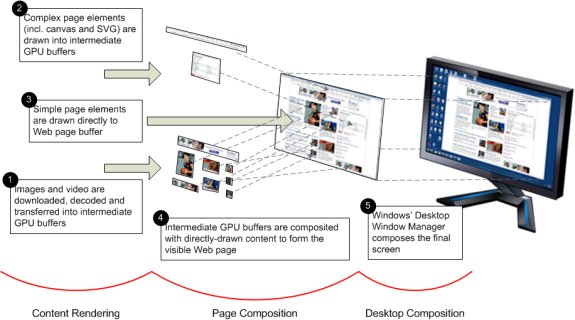
Posted on Monday, September 13 2010 @ 18:54 CEST by Thomas De Maesschalck
Microsoft's Ted Johnson discusses the new hardware acceleration features of Internet Explorer 9 at IEBlog, you can read it
over here.
Browsers can use hardware to accelerate none, some, or all of the steps in rendering an HTML pages. The diagram below illustrates the major steps in HTML page rendering in IE9.
Content Rendering. IE9 accelerates the first phase, Content Rendering, using Windows’ Direct2D and DirectWrite subsystems. As shown back in November, the results here include much smoother text and vector graphics. Accelerating this phase using the GPU (Graphics Processing Unit) improves the display performance of the most common HTML elements: text, images, backgrounds, and borders.
Page Composition. IE9 uses Direct3D for the next phase, Page Composition, giving IE awesome performance in image-intensive scenarios (like Flying Images and FishIE Tank). Accelerating this phase takes advantage of one of the GPU’s most significant features: the ability to draw bitmap images at very high speed. Moreover, because the GPU’s private memory retains images, redraw of pages heavy in images is very fast.
Desktop Composition. After a browser renders content and composes pages, Windows Vista and Windows 7 use the GPU to compose the final screen display via the Desktop Window Manager (DWM). Because IE9 uses DirectX and only DirectX, there is better interaction between IE9 and the DWM, using less GPU memory and resulting in better stability than browsers that mix different subsystems.

